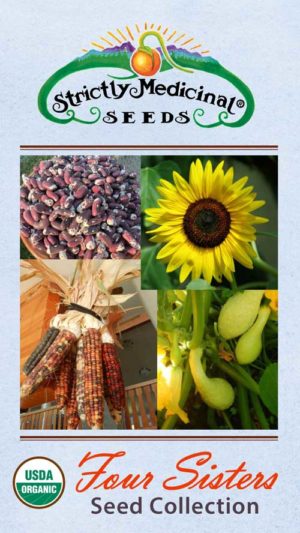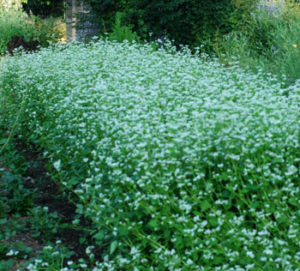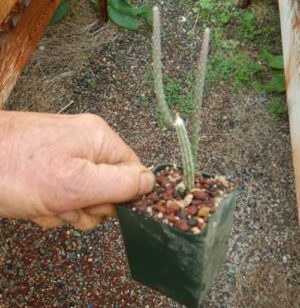Thistle, Milk (Silybum marianum) seeds, organic [WA no]
Price range: $3.95 through $20.10
Family: Aster (Asteraceae)
Hardy to Zones 6 to 9, otherwise grown as a spring-planted annual, 120 days to seed harvest
Annual or overwintering annual, native to the Mediterranean and widely naturalized. Giant, shiny-leaved plant with distinct white variegations, producing bright purple flowers that engender hefty brown-black seeds. Traditional usage (TWM): hepatoprotective, jaundice, hepatitis. Plant prefers moist, rich soil and full sun to part shade. Does very well at the coast, but can certainly be grown inland. Best to sow seed in late summer, allow the rosette to overwinter, then harvest ripe seed the following year. In zone 5 and lower it may be possible to direct seed in the very early spring and pull off a harvest by fall. At harvest, wear gloves, cut off the partially dried capitulae and drop in a bucket, further dry in the sun for a few days, then thresh with a stick until the seedhead is well broken apart, and screen and wind winnow until you get pure seed. The plant is surprisingly seed productive and although it takes some work to get the goodies out, it is well worth it. Tap-rooted plant does poorly in pots and is best sown directly in the soil. Plant all the seeds, because as nature would have it, some of them come up right away and some lie dormant to come up another day. Thin to 3 feet apart in the row and 5 feet apart between the rows–if planted too densely, you will not be able to get in to get the seeds!
Packet contains 30 seeds
10 g contains ~500 seeds
Certified Organically Grown. Not available to the state of Washington

![Thistle, Milk (Silybum marianum) seeds, organic [WA no]](https://strictlymedicinalseeds.com/wp-content/uploads/2016/11/Milk_thistle_Flower_2022_700.jpg)
![Thistle, Milk (Silybum marianum) seeds, organic [WA no] - Image 2](https://strictlymedicinalseeds.com/wp-content/uploads/2016/11/Milk_thistle_leaf_500.jpg)
![Thistle, Milk (Silybum marianum) seeds, organic [WA no] - Image 3](https://strictlymedicinalseeds.com/wp-content/uploads/2016/11/Milk_thistle_annabeth_700.jpg)
![Thistle, Milk (Silybum marianum) seeds, organic [WA no] - Image 4](https://strictlymedicinalseeds.com/wp-content/uploads/2018/03/milk-thistle.jpg)
![Thistle, Milk (Silybum marianum) seeds, organic [WA no] - Image 5](https://strictlymedicinalseeds.com/wp-content/uploads/2018/03/NadjaMilkThistle.jpg)
![Thistle, Milk (Silybum marianum) seeds, organic [WA no] - Image 6](https://strictlymedicinalseeds.com/wp-content/uploads/2018/03/Milk_thistle_flowers.jpg)
![Thistle, Milk (Silybum marianum) seeds, organic [WA no] - Image 7](https://strictlymedicinalseeds.com/wp-content/uploads/2018/03/Milk-thistle-boy-collects-Richo-Cech.jpg)
![Thistle, Milk (Silybum marianum) seeds, organic [WA no] - Image 8](https://strictlymedicinalseeds.com/wp-content/uploads/2020/11/milk-thistle-plant-with-many-flowers-11-2020-scaled.jpg)
![Thistle, Milk (Silybum marianum) seeds, organic [WA no] - Image 9](https://strictlymedicinalseeds.com/wp-content/uploads/2018/03/Milk_Thistle_Flower_2009.jpg)
![Thistle, Milk (Silybum marianum) seeds, organic [WA no] - Image 10](https://strictlymedicinalseeds.com/wp-content/uploads/2016/11/Milk_thistle_capitula_with_seeds.jpg)
![Thistle, Milk (Silybum marianum) seeds, organic [WA no] - Image 11](https://strictlymedicinalseeds.com/wp-content/uploads/2016/11/milk-thistle.jpg)




Linda –
Thanks so much, Richo. I value your experienced input highly. This takes a load off my mind as to what to do with it. Kindly, thanks again! Linda
Upvote if this was helpful (0) Downvote if this was not helpful (0) Watch Unwatch Flag for removal
Linda –
Thanks, Richo, I appreciate your advice. I will proceed as you have instructed. I’m new to all this and am learning rapidly.
I have another question. I have 5 acres that’s mostly grassy but had wild parsnips in it and a farmer told me to spray with 2-4-D to get rid of them.
I did that but now not sure that was a good idea. What should I do with that land if eventually I’d like to run some sheep or goats on it? And do I need to dig up what’s left of the wild parsnips or individually spray them to kill them out? Thanks so much for your help, Richo.
Upvote if this was helpful (0) Downvote if this was not helpful (0) Watch Unwatch Flag for removal
Richo Cech –
Hi Linda,
Thanks for staying in touch. If the area is very dry, you may have to wait for a rainy period or fall or spring-like weather to proceed. Mow the area, rototill it to create a seedbed and plant red clover. This will help rid the ground of toxins while increasing soil fertility and tilth. You don’t worry about the weeds, they will be crowded out by the clover. you may want to wait a year before graazing, both to allow toxins to diminish and to allow the food value of the clover to increase. richo
Upvote if this was helpful (1) Downvote if this was not helpful (0) Flag for removal
Linda –
Hi, Mr. Cech:
I live in zone 5, would I be able to somehow grow the milk thistle in my area? There is some wooded area along a fence line. The property is up on a hill so the wind comes thru it pretty good when it’s windy. Lovely area with a marsh on one side and farm pasture next door. I have 6 acres of land that has wild parsnip. How do I get rid of it? Or, can animals eat it say in a pasture type setting? Don’t know how to handle that. Thanks for your help.
Upvote if this was helpful (0) Downvote if this was not helpful (0) Watch Unwatch Flag for removal
Richo Cech –
Hi Linda,
Thanks for contacting. Given that your area is too cold to overwinter milk thistle, and given that milk thistle seed is commercially available, I would advise to buy the milk thistle seed and find other herbs and trees to grow–ones that will thrive for you in the relatively cold climate. The best approach is to mow and till to prepare a seedbed and sow a covercrop like peas and oats the first year, then proceed to garden it the second year. My book “Growing Plant Medicine Vol 1” would be a great help to you in this endeavor. All the best, richo
Upvote if this was helpful (0) Downvote if this was not helpful (0) Flag for removal
Rebecca (verified owner) –
I purchased milk thistle seeds from you and am preparing to plant this spring. It appears that a single plant can get quite large. I’m curious though, do they put our multiple flowers or just a single flower stalk per plant? I’m interested in growing to harvest seed and I’m trying to estimate how many to plant. Thanks!
Upvote if this was helpful (0) Downvote if this was not helpful (0) Watch Unwatch Flag for removal
Richo Cech –
Hi Rebecca,
Thanks for getting in touch, and I’m happy to try to clarify this. Plants can get quite large in the right circumstances, although the largest arev fall-planted, overwintered as a rosette and flowering midspring. Generally there are many flowers per plant. We harvested 3 Kg (over 6 lbs) of seed from one plant this year by staying on top of it and snipping the capitulae just as they started to tuft out. But smaller spring-grown plants might make far less seed. You can find out more about growing this fantastically well-endowed plant by reading “Growing Plant Medicine Vol 1.” All the details on cultivation and harvest are there. All the best, richo
Upvote if this was helpful (0) Downvote if this was not helpful (0) Flag for removal
lauren –
are these toxic?
Upvote if this was helpful (0) Downvote if this was not helpful (0) Watch Unwatch Flag for removal
Richo Cech –
no, they are edible and delicious
Upvote if this was helpful (0) Downvote if this was not helpful (0) Flag for removal
Alicia Wills –
I planted these not expecting to see anything until the 2nd year (not sure where I got that misinformation) but I was pleasantly surprised to see the stalk come up and flower (I had already juiced some of the leaves from another plant that I had planted too close to thrive). The initial flower looked sickly so I just left it alone just to see how the whole process would play out. I was shocked a few weeks later to see several flowers seemingly coming from the same plant. Now that I have grown it and learned how to properly space it and deal with the spiky leaves, it will be a welcome addition to my new garden. Thanks so much for the good seed!
Upvote if this was helpful (2) Downvote if this was not helpful (0) Watch Unwatch Flag for removal